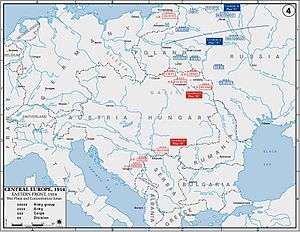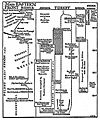Eastern Front (World War I) facts for kids
The Eastern Front of World War I was the theatre in which Germany and Austria-Hungary fought Russia. This front had more troops than the Western Front but was at least three and up to five times longer. Planning where to concentrate forces was very important because railways were few and troops could not be moved and reinforced as quickly as on the Western Front.
Russia lost many battles, but her overall situation improved as she improved her forces and more and more allies entered the war on her side. The Eastern Front ended when the Russian Civil War broke out between the Communists and Russian Social-Democratic Party in 1917 and the Communists signed a peace treaty with Germany so they could focus on winning the Civil War.
Images for kids
-
A timeline of events on the Eastern and Middle-Eastern theatres of World War I
-
Border changes in favor of Romania as stipulated in the Treaty of Bucharest
-
Illustration from the French magazine Le Petit Journal on the Bosnian Crisis. Bulgaria declares its independence and its prince Ferdinand is named Tsar. Austria-Hungary, in the person of Emperor Francis Joseph, annexes Bosnia and Herzegovina, while the Ottoman Sultan Abdul Hamid II looks on helplessly.
-
Hindenburg at Tannenberg, by Hugo Vogel
-
Territory lost by Russia under the 1918 Treaty of Brest-Litovsk
See also
 In Spanish: Frente oriental (Primera Guerra Mundial) para niños
In Spanish: Frente oriental (Primera Guerra Mundial) para niños












